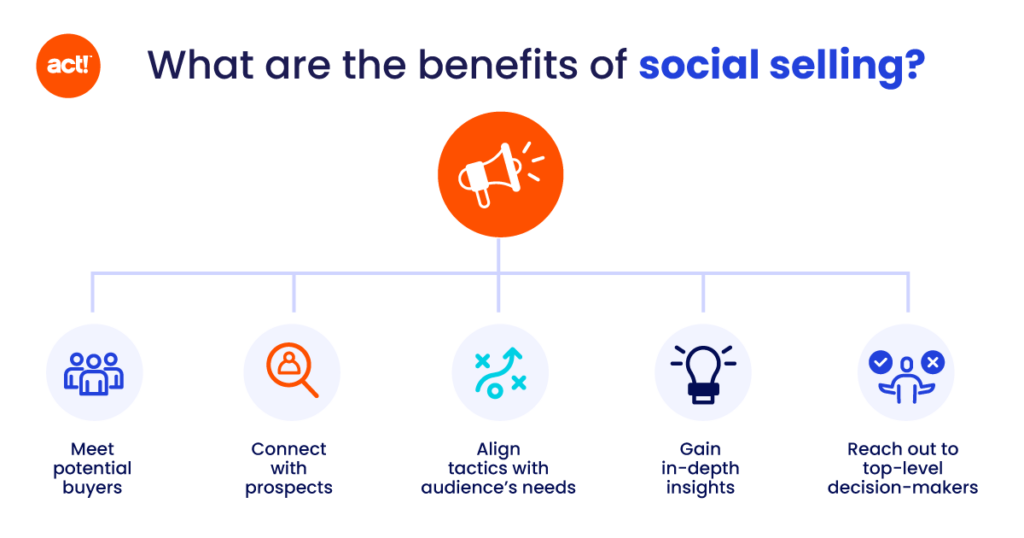With over 5 billion users worldwide, social media platforms have become an invaluable tool for businesses to connect with their target audience. Beyond just engagement, social media plays a crucial role in lead generation and relationship building, making it an essential component of any sales strategy—whether you’re launching a new business or scaling an existing one.
However, effective social selling requires more than just sporadic content posts. It demands a well-defined strategy to engage the right B2B buyers, build trust, and convert them into customers.
In this guide, we’ll explore the benefits of social selling and share best practices to help you succeed.
What Is Social Selling?
Social selling is the practice of using social media platforms to identify, engage, and convert potential customers. It’s about establishing relationships with prospects rather than immediately pushing for a sale.
Unlike social media marketing, which focuses on brand awareness and content distribution, social selling involves direct, personalized interactions with potential buyers. Sales professionals use these interactions to build credibility, address customer pain points, and guide prospects toward a purchase decision.
The Benefits of Social Selling

One of the key advantages of social selling is that it allows businesses to meet potential buyers where they already spend time. Whether you’re targeting C-suite executives or entry-level professionals, they are likely active on at least one social media platform.
Additionally, social selling offers:
- Scalability: Connecting with prospects online is more efficient and cost-effective than traditional networking events.
- High-Quality Leads: Social platforms provide access to a wealth of data, helping sales teams target the right audience.
- Marketing and Sales Alignment: Social listening tools enable businesses to track brand mentions, competitor activity, and industry trends, allowing for personalized outreach.
- Access to Decision-Makers: Social selling allows you to engage directly with top-level executives, bypassing traditional gatekeepers.
- Other Key Benefits:
- Increased brand visibility
- Enhanced reputation and credibility
- Stronger customer trust and loyalty
- Shortened sales cycles
Choosing the Right Social Media Platforms for Social Selling
Selecting the appropriate social media channel is crucial for successful social selling. Different platforms serve different purposes:
- LinkedIn: The top choice for B2B sales, LinkedIn is favored by business professionals and decision-makers. Tools like LinkedIn’s Social Selling Index and Sales Navigator help optimize prospecting efforts.
- X (formerly Twitter): With its focus on public discussions, X is ideal for engaging in industry conversations and establishing thought leadership.
- Facebook, Instagram, and TikTok: While these platforms are primarily used for entertainment, they can still be leveraged to enhance brand awareness and attract potential leads.
Rather than following a one-size-fits-all approach, businesses should focus on the platforms where their ideal customers are most active.
Best practices to get started with social selling success
To maximize the impact of social selling, businesses need a strategic approach. Here are some key practices to follow:
1. Build a Strong Personal Brand
Your social media profiles should reflect your expertise and credibility. Ensure they include:
- A professional profile photo
- A compelling summary of your experience and industry knowledge
- Endorsements and testimonials from colleagues and clients
- High-quality content relevant to your audience
2. Utilize Social Listening
Social listening tools can help you track conversations related to your brand, products, competitors, and industry trends. This allows you to identify potential leads and engage in meaningful discussions.
3. Engage Through Comments and Conversations
Engagement goes beyond posting content. Regularly interact with your audience by:
- Responding to comments on your posts
- Commenting on your prospects’ posts with valuable insights
- Initiating discussions that add value without immediately pushing a sales pitch
4. Share Social Proof
Demonstrate your credibility by sharing:
- Customer testimonials
- Success stories and case studies
- Podcasts or video interviews featuring satisfied clients
This helps build trust and allows prospects to see real-world applications of your offerings.
5. Know When to Take Conversations Offline
While social media is a great starting point, closing deals often requires moving discussions to more personal channels like email, phone calls, or in-person meetings. Pay attention to signals that indicate when a prospect is ready for a deeper conversation.
Elevate Your Social Selling Game
As social media continues to evolve, businesses must embrace social selling to stay competitive. However, success requires a thoughtful approach—building authority, engaging with prospects authentically, and transitioning conversations at the right time.
A customer relationship management (CRM) tool like Act! can streamline lead tracking and help optimize your social selling strategy. Start your free trial today and see how it can enhance your sales process.


